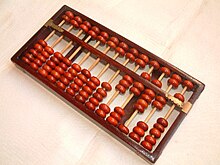Calculation
A calculation is a deliberate process that transforms one or more inputs into one or more results, with variable change. The term is used in a variety of senses, from the very definite arithmetical calculation of using analgorithm, to the vague heuristics of calculating a strategy in a competition, or calculating the chance of a successful relationship between two people.
For example, multiplying 7 by 6 is a simple algorithmic calculation. Estimating the fair price for financial instruments using theBlack–Scholes model is a more complex algorithmic calculation.
Statistical estimations of the likely election results from opinion polls also involve algorithmic calculations, but produces ranges of possibilities rather than exact answers.
To calculate means to ascertain by computing.[citation needed] The English word derives from the Latin calculus, which originally meant a small stone in the gall-bladder (from Latin calx). It also meant a pebble used for calculating, or a small stone used as a counter in an abacus (Latin abacus,Greek abax). The abacus was an instrument used by Greeks and Romans for arithmetic calculations, preceding the slide-rule and the electronic calculator, and consisted of perforated pebbles sliding on iron bars.












![{\displaystyle \scriptstyle {\sqrt[{\text{degree}}]{\scriptstyle {\text{radicand}}}}\,=\,}](https://wikimedia.org/api/rest_v1/media/math/render/svg/5582d567e7e7fbcdb728291770905e09beb0ea18)





Comments
Post a Comment